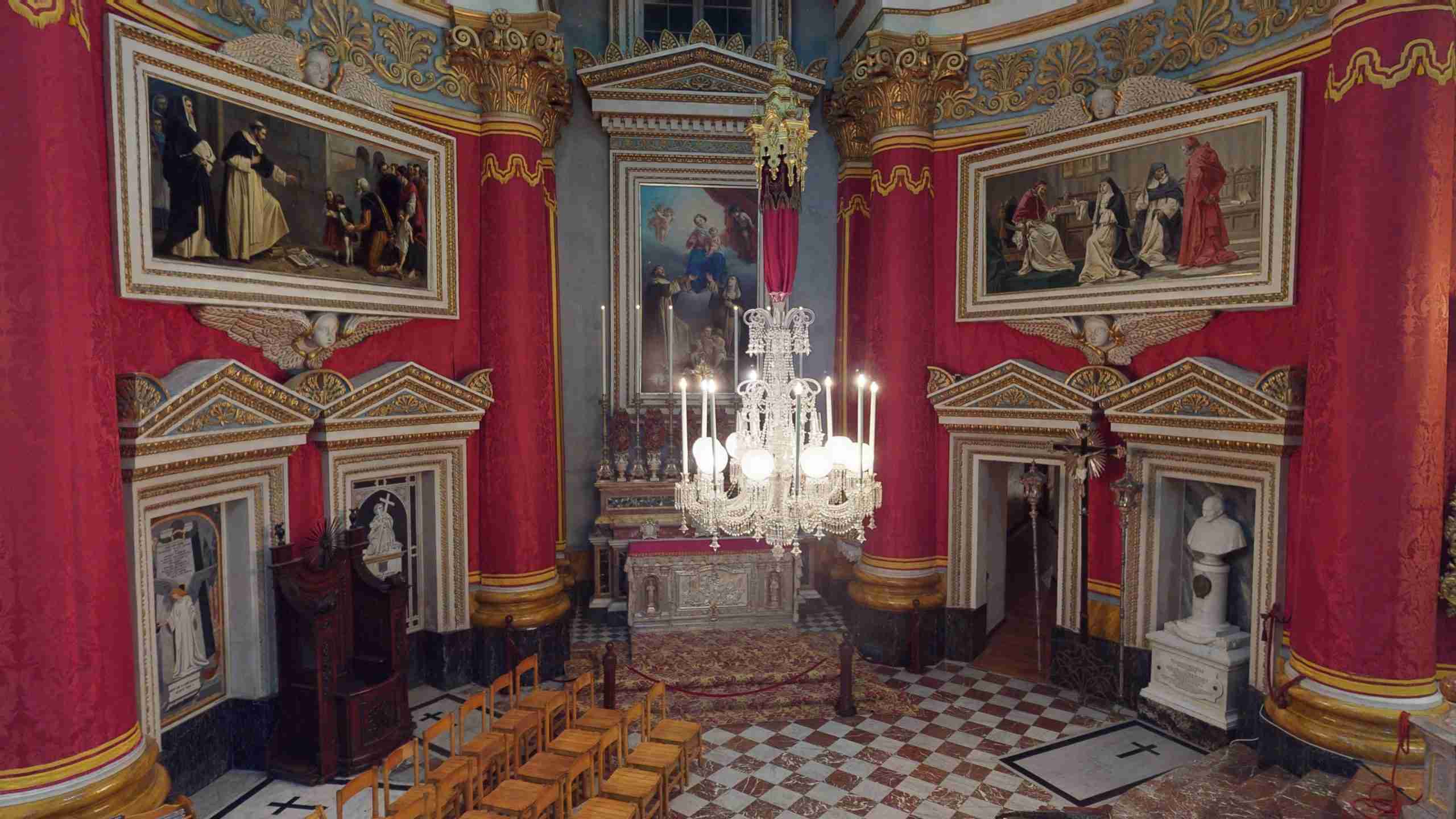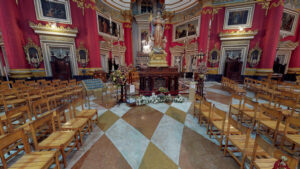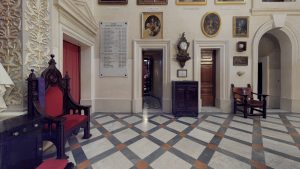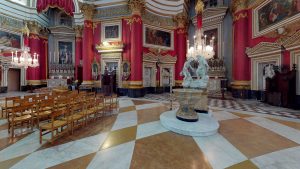
This is a 3D Walk-Through Virtual Tour. To interact, click or tap the screen and 'walk' around.
WELCOME!
to
The Basilica of the Assumption of Our Lady!
On this page you will find a number of features that will give you a good perspective and understanding of the colourful history of this amazing Church.
Click/Tap to View

The Sanctuary Basilica of the Assumption of Our Lady (Santwarju Bażilika ta’ Santa Marija), was built between 1833 and the 1860s to neoclassical designs of Giorgio Grognet de Vassé, on the site of an earlier Renaissance church which had been built in around 1614 to designs of Tommaso Dingli.
The design of the present church is based on the Pantheon in Rome, has the third largest unsupported dome in the world and is Malta’s largest and most famous church. The church narrowly avoided destruction during World War II when on 9 April 1942 a German aerial bomb pierced the dome and fell into the church during Mass, but failed to explode. This event was interpreted by the Maltese as a miracle.
History
 Although Pietro Dusina recorded Mosta as a parish in his 1575 pastoral visit, the town actually became a parish in 1608. Plans to construct a new church began soon afterwards, and the church was built in around 1614 to designs attributed to the Renaissance architect Tommaso Dingli. This church was commonly called Ta’ Ziri.
Although Pietro Dusina recorded Mosta as a parish in his 1575 pastoral visit, the town actually became a parish in 1608. Plans to construct a new church began soon afterwards, and the church was built in around 1614 to designs attributed to the Renaissance architect Tommaso Dingli. This church was commonly called Ta’ Ziri.
By the 1830s, this church had become too small to cater for the town’s population. Giorgio Grognet de Vassé proposed rebuilding the church on a neoclassical design based on the Pantheon in Rome. Despite opposition from Bishop Francesco Saverio Caruana, the design was approved and construction of the church began on 30 May 1833.
The new church was built around the old church, which remained in use throughout the course of construction. The residents of Mosta helped in building the church, taking part in construction work on Sundays and public holidays. Since Grognet had never received any formal architectural training, he received consultation services from an architect of the Sammut family.
church, which remained in use throughout the course of construction. The residents of Mosta helped in building the church, taking part in construction work on Sundays and public holidays. Since Grognet had never received any formal architectural training, he received consultation services from an architect of the Sammut family.
The rotunda took 28 years to build, being completed in the early 1860s. The old church was demolished in 1860, and the new church did not need to be consecrated since the site had remained a place of worship throughout the course of construction. The church was officially dedicated on 15 October 1871.
During World War II, the town of Mosta was prone to aerial bombardment due to its proximity to the airfield of RAF Ta Kali. At about 16:40 on 9 April 1942, the Luftwaffe dropped three bombs on the church, and two of them deflected without exploding. However, one 50 kg (110 lb) high-explosive bomb pierced the dome and entered the church, where a congregation of more than 300 people was awaiting early evening Mass. The bomb did not explode, and a Royal Engineers Bomb Disposal unit defused it and dumped it into the sea off the west coast of Malta. This event was interpreted as a miracle by the inhabitants, and a similar bomb is now displayed in the sacristy at the back of the church, under the words Il-Miraklu tal-Bomba, 9 ta’ April 1942 (meaning “The Bomb Miracle, 9 April 1942”).
On 12 December 1973, Pope Paul VI issued a decree of canonical coronation of the titular painting of Our Lady of the Assumption, therefore elevating the church to the title of Marian Sanctuary.
In 2015, the parish requested to the Vatican to be reclassified to the status of a basilica. The church was elevated to a minor basilica on 29 July 2018 by decree of Pope Francis.
Architecture
 The Rotunda of Mosta is built in the neoclassical style, and its structure is based on the Pantheon in Rome. Its façade has a portico with six Ionic columns, which is flanked by two bell towers. Being a rotunda, the church has a circular plan with walls about 9.1 m (30 ft) thick supporting a dome with an internal diameter of 37.2 m (122 ft). At one time, the dome was the third largest in the world. The church’s interior contains eight niches, including a bay containing the main entrance and a deep apse with the main altar.
The Rotunda of Mosta is built in the neoclassical style, and its structure is based on the Pantheon in Rome. Its façade has a portico with six Ionic columns, which is flanked by two bell towers. Being a rotunda, the church has a circular plan with walls about 9.1 m (30 ft) thick supporting a dome with an internal diameter of 37.2 m (122 ft). At one time, the dome was the third largest in the world. The church’s interior contains eight niches, including a bay containing the main entrance and a deep apse with the main altar.
Before the church was constructed, there was some opposition to Grognet’s design, since some regarded a Roman temple as an unsuitable model for a Catholic church building. However, others praised the design, and an 1839 book written while the church was being built describes it as “certainly the most magnificent, extensive and solid modern building” in Malta. This book further states that “when finished, the church will be an ornament to the Island, will immortalise the architect, and draw towards the casual every visitor to Malta.” The design was well-received upon completion, and it is regarded as Grognet’s masterpiece.
Il-MOSTA
Mosta, in contemporary times witnessing the construction of many new houses. New built-up zones with residential houses are found on the outskirts of older Mosta. These new zones are known as: Santa Margerita, Tal-Blata l-Għolja, Iż-Żokrija, Is-Sgħajtar and Ta’ Mlit. This means that the population of Mosta is in continuous increase. Mosta has also become a bustling commercial centre. All these developments have made Mosta a big town by local standards and it is today among the largest in the Maltese Islands.
History
Mosta has been inhabited since pre-history. Dolmens in the limits of Mosta and cart ruts are primary evidence of this. Each dolmen has two rectangular standing stones and one other similar stone positioned horizontally above the other two.
In the Middle Ages, Mosta was a small hamlet amongst a number of other hamlets, each sparsely populated. These tiny villages were Raħal Calleja, Raħal Ħobla, Raħal Pessa or Pise, Raħal Sir, Raħal Kircipulli, Raħal Brabar and Raħal Dimech. In the sixteenth century these hamlets decreased in importance and Mosta took its place as the principal village. The Apostolic Visit of Monsignor Pietro Dusina in 1575 indicated that even the church dedicated to the Assumption that stood in Mosta was so important in the area that it was erroneously called ‘parochial church’. In this year there were 580 persons living in Mosta.
The town has several legends such as The Bride of Mosta (L-Għarusa tal-Mosta), and a number of historic places such as the Victoria Lines and medieval chapels.